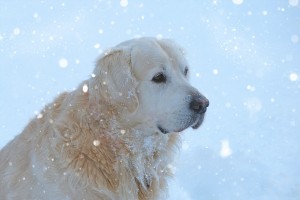Dog Safety Tips: Snow Survival Guide
 With all of the snow we have received recently, it only seems fitting to share these dog friendly snow survival tips. Whether you and your furry companion prefer to bear the elements or avoid them, chances are at least a few of these will come in handy between now and the last snowfall of the season.
With all of the snow we have received recently, it only seems fitting to share these dog friendly snow survival tips. Whether you and your furry companion prefer to bear the elements or avoid them, chances are at least a few of these will come in handy between now and the last snowfall of the season.
When Temperatures Dip
When setting out into the cold, make sure your pup is prepared. Boots can help to protect sensitive paws. Even if you do not typically take your dog out on a leash, it’s a good idea to use one in the snow. It’s easier to lose sight of a dog in deep snow and they are more likely to become disoriented.
Limit time spent outdoors. While your dog still needs to stretch his or her legs regardless of temperature, they also need to be protected. Pay attention to weather reports and limit time spent outside accordingly.
It’s a common misconception that all dogs are equipped to survive extreme temperatures. In fact, young puppies, older dogs and those that live with certain health conditions can suffer dangerous side effects as a result of overexposure to cold temperatures. Cold related health complications require a dog to be immediately moved to a warm, dry environment and veterinary attention may be required. Hypothermia and frostbite can both be life threatening. If your dog has been exposed to extreme temperatures and begins displaying signs of shallow breathing, lethargy and/or skin discoloration, seek medical attention immediately.
Put Chemicals Out of Reach
Anti-freeze and ice-melters are an essential part of everyday life during the Colorado winter. Oftentimes pet owners do not realize just how dangerous these chemicals can be to their furry friends. If you have either of these on hand, make sure they are out of reach. The sweet taste of antifreeze makes it very appealing to animals, yet as little as one teaspoon can be deadly to a small dog.
Ice-melters can cause painful skin inflammation. Even if you don’t use ice-melters at home, they can be found on streets and sidewalks. Be sure to wipe your pet’s paws down carefully after taking them on walks or allowing them outside. If your pup has long hair or short legs, it’s important to wipe their coat and/or exposed skin down as well.
Winter Beauty Tips
If you regularly bathe your dog at home, it is critical to ensure they are complete dry before allowing them to venture outside. If they are spending more time inside than they do in warm weather months, keep an eye on their claws. Less activity typically enables claws to grow faster. Finally, consider allowing your pup’s coat to grow a little longer than usual. This provides a much needed extra layer of insulation.
Have Fun!
Snowy winters are part of the beauty of living in Colorado. If you and your family enjoy outdoor activities in the winter, we encourage you to include your pet whenever possible. Just keep in mind that they are susceptible to certain cold weather related health issues.
Would you like to receive more information designed to help your furry friends remain happy and healthy year round? Follow our blog! Here we will be sharing tips and tricks to do just that.
